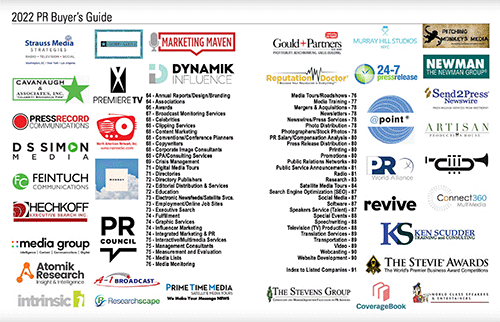 |
| Stephen Marcinuk |
Traditional PR firms act like something of a black box: they sell access to their media relationships, which can result in press coverage for clients. But how they get these wins and the work that goes on behind the scenes is often a mystery.
While this traditional agency model has stood strong for decades, we’re undoubtedly on the cusp of massive changes in the industry. A major shift is taking place regarding how transparent client-agency relationships are, how those relationships are managed and how technology can facilitate the process.
One potentially disruptive entrant in PR tech is the self-serve Software-as-a-Service platforms, which have the potential to cut out agencies altogether. These services enable businesses to manage and execute their own PR campaigns with minimal time investment. The systems also allow companies to build and own direct relationships with journalists and communicate with them instantly. Users can even receive instantaneous feedback on what’s working and what isn’t.
While these developments are intriguing, they have also made the marketplace more bewildering for those who haven’t kept pace. The self-serve systems could have wide-ranging implications for traditional PR agencies, which now need to demonstrate added value to compete with these new offerings. They will also need to do some serious soul-searching about how much transparency they provide, as well as how well they manage information exchange.
Opening up the black box
These new SaaS PR platforms could catch many traditional PR firms off guard. The systems provide customers with a raft of data about potential coverage, as well as specific media outlets, even journalists, that users can approach. The analytics and insights these platforms can produce were unimaginable only a few years ago. This data is, of course, useless if a company doesn’t know how to understand or implement it, but it’s fairly easy for them to learn how—and quickly.
The SaaS systems provide quantifiable and precise measurements, from deep data analysis to a simple tally of Instagram likes. The systems not only enable better decision-making and relationship building, but they also provide clients with their own PR dashboards, as well as complete oversight of everything they’re paying for, something traditional PR firms have classically struggled to provide.
What’s more, this SaaS technology is a great match for its target customer, who are often digital marketers adept at analyzing data and using this to aid decision-making. For example, many digital marketers would find it impossible to do their day job without access to third-party search engine marketing tools and the insights they provide.
Agencies, on the other hand, are struggling to keep up, often using outdated reporting and measurements like “share of voice.” Such metrics provide little actionable insights that can help teams to optimize their campaigns. This is akin to a paid-ads platform telling you only how many users saw an ad. Without further metrics, it would be impossible to judge the success of the ad or ways to optimize it.
Time to rethink PR relationships?
The central paradigm of traditional PR is that clients are paying to gain access to the agency’s media relationships. As soon as a client leaves an agency, those relationships are lost. These media relationships are a large part of what gives an agency its value in the marketplace. Agencies often build these relationships over years of carefully cultivated interactions, with plenty of face-to-face networking.
But SaaS PR platforms are starting to turn this paradigm on its head. With these new platforms, businesses can build their own media relationships and—crucially—hold onto them. Clients are understandably beginning to question why they should pay PR companies to do what they can now do from their laptops.
This poses an almost existential question. As SaaS PR platforms start to take market share and businesses get used to building their own media relationship, can the agency model of keeping a tight grip on their relationships and effectively “leasing” these to clients continue?
The good news for traditional PR agencies is that many clients, especially larger companies, won’t want to take the PR process on themselves and will be happy to continue to pay agencies for their services.
But on the other hand, it’s foreseeable that other companies may start expecting PR agencies to open up their black box and be more forthcoming in sharing access to their relationships, lest they switch from an agency to a SaaS PR platform.
A further interesting trend to keep a close eye on is how startups use SaaS PR platforms. The low cost and high scalability offered by these platforms are well suited to the bootstrapped model of your typical pre-revenue startup. If in-house marketers have been successful in winning impactful media coverage using these platforms, will these businesses be incentivized to keep using this model, once they secure significant funding, instead of contracting the services of a traditional agency?
Of course, there’s an argument to be made for the intangible benefits of human interaction and personalized relationships that the traditional PR model can provide. Just as a growing demand for artisanal crafts and specialty foods continues to transform the marketplace, PR clients may demand a more customized and synergistic experience from their client-agency relationships.
Moving forward
The traditional agency model and client relationship management are clearly at a crossroads, brought about by the advent of the self-serve SaaS PR model, among other tech-enabled innovations. Traditional firms clearly need to decide how they will respond to the challenge, including pulling back the curtain on their black box and responding to the expectations of today’s clients.
***
Stephen Marcinuk is co-founder and head of operations at Intelligent Relations, a PR platform that uses artificial intelligence and GPT-powered text generation to augment and improve a variety of PR functions that have traditionally been done by agency professionals. Its proprietary technology analyses millions of online news articles and automatically generates contextually relevant media pitches on behalf of clients.



 Developing a well-designed TV campaign involves asking three important questions.
Developing a well-designed TV campaign involves asking three important questions. How a "Covid silver lining" can show the way to more effective, cost-efficient video communications.
How a "Covid silver lining" can show the way to more effective, cost-efficient video communications.


 Have a comment? Send it to
Have a comment? Send it to 
Apr. 6, 2022, by Joe Honick
You are smart to publish Mr. Marcinuk's commentary, and he is damned smart to explain his ideas as well as he has. Causes me to check into the processes he describes more thoroughly than before. His points are all well made and the "smartest" among us should pay attention.